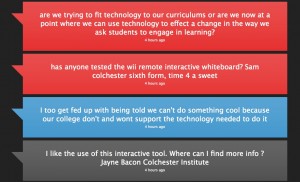A little while back (27th June, in fact) I attended the British Council for School Environments (BCSE) conference and ran an interactive session with the delegates. The session used some neat tools, including the SMS Messaging system developed by Cleveratom (now called MobiStick), but the purpose was to open up the dialogue relating to some of the issues surrounding the Building Schools for the Future (BSF) processes. The session helped gather thoughts and ideas to inform the BCSE response to the Education and Skills Committee report “Sustainable Schools: are we building schools for the future?” Read more
Learning Space Design
BCSE Seminar 2008, Building Better Schools, BSF
Friday 27th June was the date for the BCSE seminar at Westminster Academy where architects, construction companies, designers and all interested in the BSF (Building Schools for the Future) Programme met up to look at some of the issues they all face.
Cleveratom were there to provide an interactive session and encourage the delegates to ask questions. To do this I worked with half of the group (there were just too many delegates to fit in one room) and used the ever improving SMS tools that we are developing. The current incarnation is dubbed as ‘Walls iStream’, meaning text that is streamed onto a wall… Hais has been refining the interface and making it more linear than the previous versions, although we see a space for both in the future. The current version looks like this:
What we have seen is that architects are desperately keen to get the design of new schools right, and that they are under immense pressures from a number of different angles to confrm in one way or another with guidelines that limit the way spaces can be developed.
The BCSE event served to really highlight some of the issues to a wider audience and encouraged wider dialogue between people involved in BSF work.
Ty Goddard is the director for BCSE and is known as a strong campaigner for good design in schools. The responses from the event will be used to inform a document to go back to the Select Committee and let them know what is happening ‘on the street’. This is no easy task and there are many diverse views to consider.
The blog site for the seminar is http://www.buildingbetterschools.org.uk and you might like to sign up there and continue (or engage in) some of the dialogue as it unfolds. Participants at the seminar are particularly encouraged to make their views known (and felt) but anyone with an interest should have a sign in and join in the debate.
RUGroom at City College Norwich
One of the proudest moments for me recently was on Friday 8th February at City College, Norwich. This was the grand opening of the RUGroom space, which was created in less than one year and has been in use for the last few months. Our role was to initially specify the technology that would best support and extend the learning opportunities and in so doing we found we were getting more drawn in to the physical design. Not wanting to do a job badly, we called on the skills of Team A Go Go to help with the interior design. The blend of our combined knowledge and understanding of spaces and how they can be used has resulted in a unique space which is providing first class support for the students, who are all autistic.
We combined our knowledge and understanding of how technology can be used to engage learners with our approach to digital creativity and created a program of events, which we delivered to the college on a week by week basis. At the same time as this, we invited a small group to our offices in Chelmsford so that they can help specify and design the online space, too.
The opening on Friday was attended by none other than Charles Clarke, MP for the City and former Secretary of State for Education. He spoke of the potential that is within all learners and the importance of unleashing that, which of course is what we believe, too! Our programme of sessions, run brilliantly by Matthew Eaves, has shown repeatedly that there are ways to engage all learners, and it is about finding the way in… technology is important, but interestingly, not always essential. A lot depends on the learner, the subject and of course the purpose for the activity.
The BBC ‘Look East’ news team were there in the shape of Louise Holmes (who we worked alongside in 2006 with the BBC Blast project), and the event was reported on BBC Look East throughout the afternoon and early evening. A snapshot of this is available on YouTube.
There is more about all this on the Digital Creativity web site, which explores what we did, why we did it and what we found out.
BCSE, British Council for School Environments, Industry Awards 2008
It is a great honour to have been asked to help evaluate the entries for the first BCSE Industry Awards and on Friday I received a pack of entries from three categories: Innovative design for Primary Schools, Innovative Design for Secondary Schools and Best Architect. I have spent the weekend reading these and am confident that the formal evaluation day (Tuesday 27th) will be extremely difficult. The quality of the entries appears to be very high indeed and choosing the top entries will be no easy task.
It speaks volumes about the quality of the designs for new schools around the country, and the opportunities that thousands of children are getting now that they weren’t getting before. I’m delighted to be involved in BSF work throughout the country and once again it has been emphasised to me just how important this work actually is.
I can’t say which of the entries will go forward to the final evaluations, of course, but I can comfortably say that innovation is thriving!
